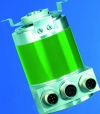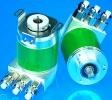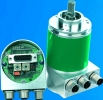
Encoders with M12 connection
Fraba Posital's Profibus DP encoders, part of the Optocode series, are now also available with integrated M12 plug connectors. This improvement means that the new models are particularly easy to install: start-up requires no more than plugging in the devices.
Encoders with M12 connection
Fraba Posital's Profibus DP encoders, part of the Optocode series, are now also available with integrated M12 plug connectors. This improvement means that the new models are particularly easy to install: start-up requires no more than plugging in the devices.
They provide the full feature set of standard Profibus encoders, including, for example, the certified Profibus functions isochronous mode and slave-to-slave communication, the possibility to set limit switches and a teach-in option which allows the user to determine the gear ratio directly on site. These devices also support the online transmission of preset values. The encoders' revised and improved version of the optoelectronic scanning method is based on the concurrent analysis of a Gray code pattern and two incremental tracks, covering a total measuring range of 30 bit. As a single-turn model, the rotary encoders' highly integrated opto-ASIC provides a resolution of 65 536 steps per revolution (16 bit). Additionally, the multiturn model registers a maximum of 16 384 revolutions (14 bit). All Optocode encoders operate without backup batteries and instantly provide current absolute position values without homing even after power failure. (Figure 1 shows the Optocode encoder with Profibus-DP interface and M12 plug).

Absolute encoders with Profibus interface
In 1994 Fraba Posital introduced the first absolute rotary encoders featuring a Profibus DP interface and has been continuously enhancing the devices since then. In addition to their functions as a class 2 encoder, the latest Optocode series features a range of assistance functions designed to support higher-level control systems, including amongst others a velocity output, software limit switches, and a teach-in option which allows users to determine the gear ratio directly on site. The Optocode Profibus encoder supports all common transmission rates up to 12 MBaud. All Optocode Profibus encoders feature the expanded DPV2 functionality (isochronous mode and slave-to-slave communication), enabling the precise and synchronous measuring of actual values. A connection cap unit, optionally available with screwed cable glands or integrated M12 plugs, facilitates assembly and network address setup. BCD rotary switches set the device address - and there is a switchable terminating resistor. Two LEDs on the unit's rear side indicate operating mode and error status. The UL-approved encoders are accredited by Profibus Nutzerorganisation e.V., a member of Profibus International. Figure 2 shows the Optocode encoder with Profibus interface.

Like all Optocode encoders, the Profibus models use a tried and tested optoelectronic scanning method to record position values. This method is based on the concurrent analysis of a Gray code pattern and two incremental tracks. As a single-turn model, the rotary encoders' highly integrated Opto-ASIC provides a resolution of 65 536 steps per revolution (16 bit). Additionally, the multiturn model registers a maximum of 16 384 revolutions (14 bit). Backup batteries are unnecessary. All Profibus models come in blind-hollow or solid shaft versions and are IP65 protected, ie, fit for use in rugged industrial environments. Stainless steel versions and encoders for hazardous environments are optionally available as well.
Optocode rotary encoders with Modbus interface
Fraba Posital's Optocode line of absolute rotary encoders now includes models with a Modbus TCP interface. The implementation of this Ethernet-based network protocol, FRABA has extended the application range for Optocode devices, including, for example, building, process and laboratory automation. The new Modbus encoders provide the full functional scope of Fraba's Ethernet TCP/IP models. Apart from position and velocity values, the output data also includes a time stamp. Each of these values can be switched in as required. The encoders can be connected to a PC, a network or Modbus PLC via a robust M12 plug. The maximum data exchange rate is 100 MBit/s via Modbus/TCP. An integrated web server provides HTML pages with embedded Java applets, allowing the encoders to be configured, read out and tested via company networks or Internet. Figure 3 shows the Optocode encoder with a Modbus interface.

High-precision AnguSens inclinometers
At this year's Hanover Fair, Fraba Posital presents a new generation of compact, biaxial inclinometers with a measuring range of 5, 15 or 30°. Their IP67 metal casing and overall robust design means that these sensors are not affected by vibration or shock and operate smoothly even in rough environmental conditions. Typical applications include construction machinery, cranes or working platforms. An embedded microcontroller accurately processes all readings: internally, the angle of inclination is measured 100 times per second, filtered and is presented at the output at a rate of 10 readings per second. High speed internal processing and customisable filters qualify the sensors for a wide range of automation applications. For easy installation, especially on non-planar surfaces, the sensors feature a three-point support on the casing which offers a safe hold and thereby ensures reliable measuring. Figure 4 shows the AnguSens inclinometer.

The sensors come equipped with a RS232- or CANbus interface combined with an analog output for current, voltage or pulse-width modulation, or two switching outputs emulating tilt switches. All CANbus models support the CANopen device profile DSP-410 for inclinometers. They are parameterised either by bus or directly on location via DIP switches. A model with a Profibus interface is currently being developed.
Optocode hollow shaft encoders
Fraba Posital's Optocode series of absolute rotary encoders now also includes models with a hollow shaft (O 12 mm) (Figure 5) that may be fitted with a torque support or clamping rings on both sides. The encoders feature an SSI interface. Alternatively, single-turn encoders with a CANopen interface are available as well. Despite their through hollow shafts, all multiturn models are equipped with Fraba's proven gearing technology. Suitable for ambient temperatures of -40 to +85°C, the devices are designed for continuous operation up to 3000 rpm.

About Fraba Posital
Fraba Posital is a highly specialised manufacturer of absolute rotary encoders and inclinometers. The company belongs to the Fraba group which dates back to 1918, when its predecessor Franz Baumgartner elektrische Apparate, a producer of relays, was established. Today, the group consists of six independent companies that develop and produce industrial sensor technology and safety equipment.
| Tel: | +27 11 383 8300 |
| Email: | [email protected] |
| www: | www.atisystems.co.za |
| Articles: | More information and articles about ATI Systems |

© Technews Publishing (Pty) Ltd | All Rights Reserved